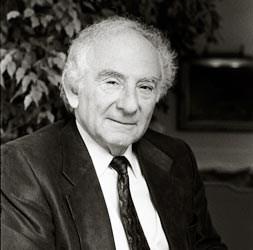Columbia College | Columbia University in the City of New York
Leon N. Cooper ’51, GSAS’54, Nobel Laureate and Pioneer in Superconductivity

Born in the Bronx on Feb. 28, 1930, Cooper graduated from Bronx Science and majored in physics, earning a Ph.D. from GSAS in 1954 and working at the Institute for Advanced Study in Princeton, N.J., for a year. In 1955, he received an invitation from Bardeen, a noted physicist who would win a second Nobel for helping to invent the transistor. Bardeen asked Cooper to join Schrieffer and himself at the University of Illinois, in trying to understand how superconductivity — simply put, the ability of certain materials to conduct a direct electric current without energy loss — works. The theory the trio came up with, named for their initials, was published in Physical Review in December 1957, solving a question that had baffled the leading physicists of the 20th century.
Years later, according to The New York Times, Cooper recalled that this was the first time he had heard of superconductivity. He said if he had been aware of how many scientists had tried and failed to explain it, he would probably not have accepted Bardeen’s offer.
Cooper’s main contribution to the BCS Theory was the discovery that electrons are attracted to each other in superconductors, when they normally wouldn’t be. These electrons became known as Cooper Pairs.
After teaching at Illinois and Ohio State, Cooper joined the faculty at Brown in 1958 and remained there for the rest of his career. He was appointed the Henry Ledyard Goddard University Professor in 1966 and the Thomas J. Watson, Sr. Professor of Science in 1974. When Cooper became interested in neuroscience, Brown created the interdisciplinary Center for Neural Science with Cooper as its director. His focus was on studying the way people learn.
Cooper was something of a bon vivant on the Brown campus, where he often drove a sporty 1968 Chevrolet Camaro convertible. After he received the Nobel, The Rhode Islander, the Sunday magazine of The Providence Journal, named him its Man of the Year and published a profile titled “Dr. Supercool and the First Nobel.” According to the Times, Sheldon Cooper, the quirky theoretical physicist played by Jim Parsons on The Big Bang Theory, was in part named after Cooper.
Cooper received an honorary degree from Columbia in 1973, a John Jay Award for distinguished professional achievement in 1985 and the Alexander Hamilton Award in 1995. In 2013 he received the Susan Culver Rosenberger Medal, Brown’s highest honor.
Cooper’s first marriage, to Martha Kennedy, ended in divorce, and he was predeceased by his sister, Lorraine. He is survived by his wife, Kay; daughters, Coralie and Kathleen; and four grandchildren.
— Alex Sachare ’71
Issue Contents
Published three times a year by Columbia College for alumni, students, faculty, parents and friends.
Columbia Alumni Center
622 W. 113th St., MC 4530, 6th Fl.
New York, NY 10025
212-851-7852
cct@columbia.edu
Columbia Alumni Center
622 W. 113th St., MC 4530, 4th Fl.
New York, NY 10025
212-851-7488
ccalumni@columbia.edu

